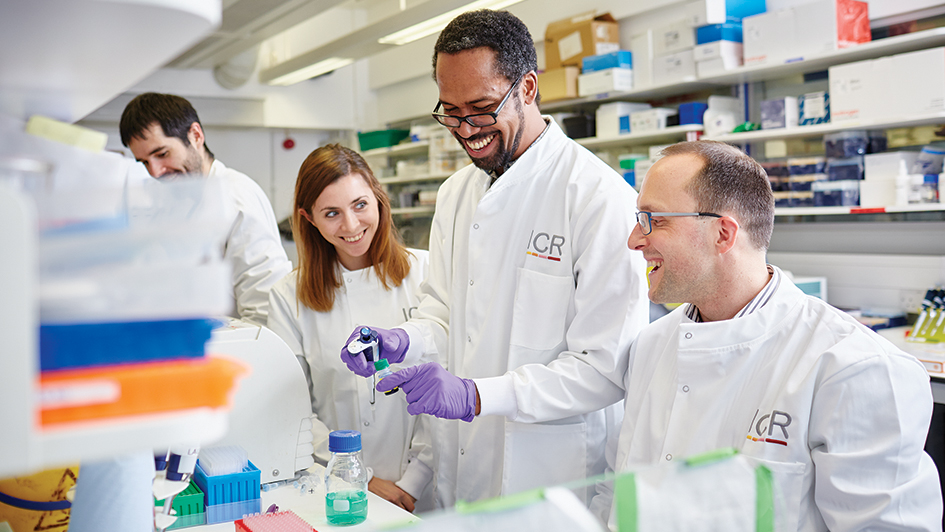
One of the most rewarding moments for a cancer researcher is when you first get to see evidence coming through from clinical trials showing that patients are benefiting from a treatment which you helped to create.
We all work in cancer research to make a difference to patients, and knowing that your work can result in people living longer, and with an improved quality of life, is enormously motivating.
But conversely, it can be incredibly frustrating and disappointing when exciting new treatments suffer long delays before reaching cancer patients and becoming part of routine care.
It’s a long road from the discovery of a drug in the lab to the first positive clinical trial results – and then onwards to seeing the drug become widely available for patients on the NHS. And at the ICR we have been worried for some time that this road seems to be getting even longer rather than shorter.
We have seen several exciting new cancer medicines, including our own prostate cancer drug abiraterone, take many years to advance from the lab through clinical trials, and then to progress through licensing on to NICE appraisal and approval – before finally becoming available to NHS patients.
It was to get to the bottom of this problem – and to try to understand where there are delays in getting drugs to patients, and what we can do about it – that we began work on a major report on cancer drug discovery and development.
'Innovation is absolutely critical'
This report, From Patent to Patient: analysing access to innovative cancer drugs, was published yesterday. It has looked at all of the 97 drugs for 177 different indications that were authorised through the European Medicines Agency (EMA) from 2000 to 2016.
We examined how many drugs were coming through the pipeline and for which types of cancer. We also looked at how quickly new cancer drugs were progressing from their initial discovery in the lab through to clinical trials, then continuing on to EMA authorisation, and finally advancing to appraisal and approval by NICE to benefit NHS patients.
And in addition we assessed how innovative each drug was – in order to see what difference this made to its chances of being successfully approved for use on the NHS.
We assessed, for example, whether a cancer drug was highly innovative because it attacked cancer in new ways or had a new class of structure that made it more effective than anything previously available.
Innovation is absolutely critical if we are to make the step-change advances we need to see in treating cancer.
This is because cancer is a moving target. Patients may often respond initially to a new drug, but all too often their tumour cells will adapt, evolve and develop resistance to treatment. The evolution of drug resistance is the single biggest challenge in cancer medicine and the reason why the disease claims so many lives.
See all of our content supporting the launch of our new report: From patent to patient – analysing access to innovative cancer drugs.
The ICR's instrumental role
We need to keep one step ahead of cancer evolution, by creating truly innovative drugs and especially ones that attack cancer in new and different ways. These highly novel and unprecedented drugs could be used on their own or in combination with others to hold the cancer in check for longer or achieve cure.
The good news from our report is that the dramatic advances we have made in our understanding of the genetics and biology of cancer are bearing fruit in the form of many new cancer treatments.
The total number of cancer drugs being licensed by the EMA has doubled in less than a decade – and many of these are exciting new personalised treatments that are targeted to particular genetic changes that can be identified by sequencing patients’ tumour DNA in the lab. Others include the highly effective new immune therapies.
The results also show that the ICR has played an instrumental in many of these treatments. We have been involved – either in the underlying biology or in the discovery or development of the drug itself – in around a fifth of all the drugs licensed by the EMA in the period of our study.
When you add in drugs developed by our colleagues at our hospital partner The Royal Marsden with academic positions at the ICR, that rises to almost a quarter.
Drugs not benefiting patients with all cancers
Unfortunately, however, in other respects our report makes sobering reading.
The bad news is that it is taking longer – close to a year and a half longer on average – for new treatments to reach NHS cancer patients.
And the exciting new drugs that are getting through, when they are finally licensed and approved on the NHS, are not benefiting patients with all types of cancer.
For cancers of the brain, womb, bladder and oesophagus (the gullet or food pipe), no new drugs were licensed at all. There were only a handful of new treatments for devastating forms of the disease such as liver, ovarian and pancreatic cancer. These are some of the hardest cancers to treat where patients desperately need faster progress.
Children's cancer drug approval too slow
We have specific concerns, too, about the frustrating situation in children’s cancer.
Children are not benefiting from the advances we have seen in cancer research at anything like the rate that adults are.
Just 8 per cent of the drugs licensed between 2000 and 2016 – and only 6 per cent of all drug authorisations by the EMA – included an indication for treating children.
Astonishingly, in the entire period we looked at, only two drugs were licensed for children’s cancers outside of leukaemias (types of blood cancers).
There are two reasons why we are not seeing enough new drugs for children with cancer. Firstly, we’re not discovering and developing enough drugs specifically for childhood cancers.
And secondly – because of a loophole in European regulations – we are unable to ensure that pharmaceutical companies assess in children drugs that they developed for adult tumours, even when there is good evidence that these treatments could work in childhood cancers.
This must change. There have been huge improvements in survival from children’s cancer over the last 40 years, but there has been a marked plateauing more recently. It is great that three-quarters of children now survive their cancer.
But rather than being treated with smarter, kinder targeted drugs, most children receive conventional chemotherapy and many experience side-effects that can be severe – and in some cases lifelong.
Our latest research shows that within the next decade, we can make acute lymphoblastic leukaemia preventable. Your support will help us make this disease a thing of the past.
Drugs taking longer to reach patients
Our report also confirms our suspicion that it is taking even longer for cancer drugs to reach patients. Over the last decade, the time it takes for a drug to move from the filing of the patent through to availability on the NHS has increased by more than a year – up from 12.7 years to 14.1 years.
So rather than getting quicker, access to new cancer drugs is actually getting slower.
Through our research we were able to pinpoint the reason for this increase – drugs are taking longer to move through clinical trials and licensing. Between 2000 and 2008, it took an average of 7.8 years for a drug to progress through clinical trials and attain EMA authorisation; between 2008 and 2016 it took 9.1 years.
This finding is especially disappointing because progressing drugs through clinical trials should be getting faster. The reason for that expectation is that our deep understanding of cancer genetics and biology means that it is now possible to assess modern targeted treatments in smaller, smarter trials – focused specifically on those patients who are most likely to benefit.
And because patients can be selected in advance for their likelihood of responding, the magnitude of the clinical benefit can be much bigger than would be the case in the old-style, much bigger, one-size-fits-all phase III trials.
So it is possible to demonstrate that a drug works in trials with much smaller numbers of patients and in a much shorter period of time. But this not happening enough.
Regulators not responding to scientific advances
Regulators have said they are willing to respond to the scientific advances in cancer by approving drugs at an earlier stage, but there is very little evidence from our data that this is actually occurring on any significant scale.
If drug companies are not confident that they will get drugs licensed based on smaller, smarter trials, they will keep on running larger, slower phase III trials in the way they always have – and we won’t see faster access for patients.
Whenever the availability of drugs for patients in the UK is discussed, one organisation that always comes under the microscope is NICE.
Our report paints a mixed picture of the effectiveness of NICE in facilitating the passage of cancer drugs to patients.
On the one hand, NICE is responding more quickly when evidence emerges that a drug is effective. NICE now starts its appraisals much earlier after authorisation by the EMA – and indeed in many cases initiates its review before a licence has been granted.
However, our figures show that once it starts an appraisal, NICE takes 16 months to complete it – almost as long as ever.
And while NICE has now committed to appraise every new cancer drug, over the time period that we looked at it is clear that this often did not happen – and seems still not to be happening.
NICE 'not prioritising innovation'
In total, only 40 per cent of the drugs authorised by the EMA had received a positive appraisal from NICE at the point of our analysis.
Perhaps the most concerning finding on the role of NICE is that it is not prioritising and encouraging innovation. In fact, we found that a highly innovative drug was actually less likely to have received a positive appraisal from NICE than a low-innovation drug.
That’s very disappointing, since we believe NICE should be playing an important role in incentivising the type of radical innovation we need to overcome cancer’s ability to evolve and become resistant to treatment – by building confidence among drug companies that when they do successfully innovate it will be rewarded by rapid approval.
In addition, our paediatric researchers believe there are particular problems with the way NICE considers drugs for childhood cancer. It’s clear that new treatments for rare diseases that affect children and young people do not fit neatly within its algorithms and processes.
Essential to ensure advances reach patients quickly
Overall, our report provides a detailed picture of where we are today in the search for new cancer treatments – and gives vital pointers for reshaping the landscape of drug discovery, development and regulation in the future.
The progress needed to deliver big improvements in cancer survival is eminently achievable, but such success will rely on creative risk taking in drug discovery and development – and on the matching of this innovation by the drug regulators.
It’s essential that we find ways of encouraging radical innovation, and ensuring that the advances that this produces reach patients as quickly as possible – so that more people with cancer can live longer, healthier lives.
